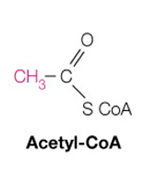Why does fat have a high caloric content?
Fat is nonpolar, highly reduced (contains many hydrogen atoms), and anhydrous (lacks water), which makes it energy-dense and yields more ATP upon oxidation.
What are the three ketone bodies?
Acetoacetate
β-Hydroxybutyrate
Acetone (non-metabolizable, exhaled in breath)
What is the purpose of the carnitine-acyltransferase system?
It transports long-chain fatty acids into the mitochondrial matrix for β-oxidation by converting fatty acyl-CoA to fatty acyl-carnitine, allowing it to cross the inner mitochondrial membrane.
What is the primary fuel source for the following tissues?
Brain, Skeletal muscle, Heart, Adipose tissue, and liver
Brain: Glucose (and ketone bodies during starvation)
Skeletal muscle: Fatty acids at rest; glucose during exercise
Heart: Fatty acids (primary), ketone bodies
Adipose tissue: Fatty acids (stored or released)
Liver: Fatty acids, glucose, amino acids
What is the structure of acetyl-CoA?
Acetyl-CoA consists of:
An acetyl group (CH₃CO–)
Linked to coenzyme A via a thioester bond
Coenzyme A includes pantothenic acid (vitamin B5), a phosphate group, and a nucleotide (adenosine 3',5'-diphosphate).

Why is the liver known as a glucostat?
Because it monitors and regulates blood glucose levels by balancing glucose production (gluconeogenesis, glycogenolysis) and storage (glycogenesis).
How many molar equivalents of ATP are produced from complete oxidation of palmitate (16C)?
106 ATP molecules are produced:
7 NADH, 7 FADH₂, and 8 acetyl-CoA from 7 cycles of β-oxidation
Acetyl-CoA enters the TCA cycle: 8 acetyl-CoA → 80 ATP
Total = 28 (from NADH/FADH₂ in β-oxidation) + 80 (from TCA) – 2 (activation) = 106 ATP
What does glucagon signal and what is its role?
Glucagon signals the fasting state and promotes:
Ketogenesis
Glycogen breakdown
Gluconeogenesis
How is fat oxidation different from fat biosynthesis?
Fat Oxidation:
Fat oxidation is the process of breaking down fatty acids to produce energy. It occurs in the mitochondria. In this process, fatty acids are broken down into acetyl-CoA units through β-oxidation. It uses the cofactors NAD⁺ and FAD, which are reduced to NADH and FADH₂ to generate ATP in the electron transport chain. To enter the mitochondria, long-chain fatty acids must be transported by the carnitine shuttle. Overall, fat oxidation produces energy for the body, especially during fasting or prolonged exercise.
Fat Biosynthesis:
Fat biosynthesis is the process of building fatty acids from smaller molecules. It takes place in the cytoplasm. The process starts with acetyl-CoA, which is converted into malonyl-CoA and then used to synthesize fatty acids. It uses NADPH as a cofactor to provide the necessary reducing power. Unlike oxidation, fat biosynthesis consumes energy in the form of ATP and NADPH. This process occurs when there is excess glucose and energy in the body, such as after eating a carbohydrate-rich meal.
What is the hormonal response after eating a carbohydrate-rich meal?
Insulin secretion is stimulated
Glucagon secretion is suppressed
This promotes glucose uptake, glycogenesis, and lipogenesis.
What is the difference between Type I and Type II diabetes?
Type I Diabetes:
Type I diabetes is an autoimmune disease where the body’s immune system attacks and destroys the insulin-producing beta cells in the pancreas. As a result, the body cannot produce insulin. This condition usually begins in childhood or adolescence, and people with Type I diabetes must take insulin injections for life to manage their blood sugar levels.
Type II Diabetes:
Type II diabetes is a metabolic disorder where the body produces insulin, but the cells become resistant to its effects, meaning glucose cannot enter the cells efficiently. Over time, the pancreas may also produce less insulin. This type is more common in adults, especially those who are overweight or inactive. It can often be managed with diet, exercise, oral medications, and sometimes insulin if needed.